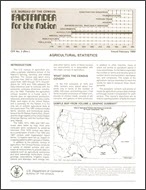
An official website of the United States government
Here’s how you know
Official websites use .gov
A .gov website belongs to an official government organization in the United States.
Secure .gov websites use HTTPS
A lock (
) or https:// means you’ve safely connected to the .gov website. Share sensitive information only on official, secure websites.
-
//
- Census.gov /
- Library /
- Publications /
- Factfinder for the Nation: Agricultural Statistics
Factfinder for the Nation: Agricultural Statistics
Factfinder for the Nation: Agricultural Statistics
Introduction
The U.S. census of agriculture provides a periodic statistical picture of the Nation’s farming, ranching, and related activities. The census was taken every 10 years from 1840 to 1920 and every 5 years from 1925 through 1974. Enumerations for 1978 and 1982 adjusted the data-reference year to coincide with the economic censuses (business, industry, etc.) for 1982. Thereafter the agriculture census reverted to a 5-year cycle. It reports data on agricultural production, resources, and inventories for every county, State, and region of the United States, and a summary for the Nation; it is the only set of uniform agricultural data at the county level. The 1987 census includes farms, ranches, and horticultural operations in the 50 States, Puerto Rico, Guam, and the Virgin Islands of the United States, American Samoa, and the Northern Mariana Islands.
The 1969, 1974, 1982, and 1987 censuses were conducted by personal interview. (The 1978 census was taken by a combination of both.) The 1982 and 1987 census used regionalized report forms; 13 regions were set up, based on cropping patterns within groups of States.
In addition to the periodic census of agriculture, the Census Bureau conducts a variety of related surveys and censuses at various times to provide data on subjects such as agricultural economics and land ownership, horticulture, cotton ginnings, corporations, irrigation organizations and drainage, farm energy use, and other topics; some of these surveys run concurrently or in association with the major census of agriculture.
Others in Series
Publication
Publication
Publication
Share
Some content on this site is available in several different electronic formats. Some of the files may require a plug-in or additional software to view.
 Yes
Yes
 No
NoComments or suggestions?


Top

